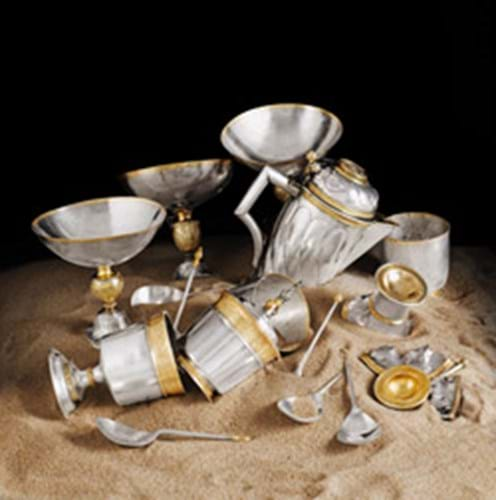
The 31-piece trove was unearthed on November 11, 2006 in Pouilly-sur-Meuse, a tiny village in Lorraine (north-east France) by a middle-aged man digging in his garden to create a well to drain off flood water from the nearby River Meuse.
When he first stumbled across the silver he thought the gleaming items were "tins of cat food"… but soon realised something tastier was involved.
The disparate ensemble - cups, beakers, salts, spoons and a ewer - spanned the period 1480-1570, with pieces made in Paris (1480-1530) and three cities of eastern France: Châlons (1520-50), Rheims (c.1550) and Strasbourg (1560-67).
Under French law, "treasure" is defined as "a hidden or buried object discovered by chance, to which no person can claim due title" and belongs to whoever discovers it, providing he/she is the owner of the land where the discovery is made; if they're not, ownership of the treasure is shared 50-50 with the land-owner.
If the treasure is not discovered "by chance" - say, if a metal detector is used - it belongs exclusively to the owner of the land.
After making his momentous discovery, the Pouilly gardener alerted his village mayor who, in turn, contacted the local museum in Bar-le-Duc. Lorraine's Director of Cultural Affairs was called in, then the Louvre, resulting in the Musées de France (national museums agency) offering 2m euros to acquire the ensemble. But when they proved unable to raise either this sum, or a revised offer of 1.4m euros, the exasperated digger approached Sotheby's, and a sale was slated for November 9.
The trove was described by Thierry de Lachaise, head of silver at Sotheby's France, as "in remarkable condition despite spending 400 years in the ground". Lachaise believes it was buried around 1590, when Pouilly, halfway between Protestant Sedan and Catholic Verdun, was caught in the cross-fire during the Wars of Religion.
"Discoveries like this rarely occur more than once a century," added Lachaise. In fact, only three other treasure troves of comparable importance have ever been found in France. The most notable, discovered at Gaillon in the Seine Valley in 1851, consisted of 14th century silver from Paris, Rouen, Amiens and Montpellier - now split between the V&A, the Hermitage, the Louvre and the Musée de Cluny in Paris.
The Pouilly Treasure includes three lots of outstanding importance: a parcel-gilt silver-covered ewer with a Paris maker's mark dating from before 1507, making it the oldest hallmarked Paris ewer known; a pair of parcel-gilt silver stacking beakers and cover, bearing the Strasbourg hallmark of Dietrich Brey (c.1527-98); and a set of 12 parcel-gilt silver spoons with the Châlons hallmark (c.1520), of note because cutlery sets "by the dozen" - a number inspired by the Last Supper - were not previously thought to have been made in France before 1680.
None of the items are engraved with coats-of-arms, but three feature an NB monogram, doubtless referring to the name inscribed on the base of the ewer (N BESCHOFER).
Meanwhile, on April 29, 2009, the ensemble was classified as a French National Treasure - giving the State a further 30 months to make an offer for it, with an export ban in force during that time.
Sotheby's planned to offer the silver in ten lots, to be auctioned first individually, then re-offered as an ensemble. As six of the ten came with "estimates on request", it is hard to say just how high Sotheby's expectations were but, despite the provisional export ban, they reported "lots of foreign interest", notably from Belgium, Holland and the UK.
Then, on November 3, just six days before the sale, it was announced that the State, after finding extra funding through (so far anonymous) corporate sponsorship, had managed to stump up the 1.4m euros for which the vendor was willing to sell.
"As a Sotheby's expert, I'm a bit disappointed we didn't auction it," admitted Lachaise. "But, as a Frenchman, I'm delighted this exceptional ensemble will remain intact and be on show to the public."
After examination and restoration by the Musées de France, it will go on permanent display at the Musée Lorrain in Nancy, one of the largest museums in eastern France, in 2011.
By Simon Hewitt




